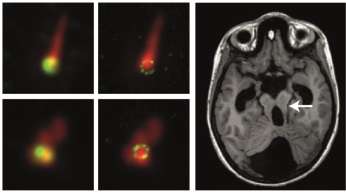International study uncovers mechanism behind Joubert syndrome

The results of an international study published in Nature Cell Biology have identified a gene (TMEM107) associated with Joubert syndrome, and crucially uncovered the mechanism by which it functions in cells, leading to a better understanding of the cause of this brain disorder.
The study was led by Conway Fellow, Dr Oliver Blacque with researchers at Burgundy University (France) and Radboud University Medical Centre (The Netherlands).
Joubert syndrome is a relatively rare genetic disease affecting 1 in 80,000 individuals. Symptoms include problems with mid-brain formation, breathing, balance and muscle control, as well as kidney defects, blindness, obesity, and bone malformation.
The syndrome is one of a number of increasingly common disorders called 'ciliopathies', caused by defects in a part of the cell called the cilium. This hair-like structure on the surface of most human cells functions as an 'antenna' for sensory perception (e.g., odour detection) and cell-cell communication during embryo development.
Recent research has focused on the base of the cilium, where it attaches to the cell. This part of the cilium is thought to act as a 'gate', controlling which molecules are allowed to enter and exit the ciliary antenna. By making sure that the cilium contains the correct molecules, the gate safeguards the normal functions of the cilium.
In this study, the researchers reveal a new gene, associated with the ciliary gate, called TMEM107 and show that mutations in this gene cause Joubert syndrome. In pioneering experiments, the scientists used sophisticated (super-resolution) microscopy to establish that TMEM107 associates with discrete sub-regions of the gate, rather than the entire structure. This finding provides new insight into the architecture of the gate at the molecular level, and provides new leads for further understanding the mechanism by which the gate operates. These observations were made not only in human cells, but also in tiny worms (C. elegans), indicating the general relevance of the findings in nature.
The work was conducted by a multidisciplinary group of researchers from UCD Conway Institute, Burgundy University (France), Radboud University Medical Centre (The Netherlands), University of Leeds (UK), University Medical Centre Utrecht (The Netherlands) and Trinity College Dublin (Ireland) with expertise in bioinformatics, human genetics, cell biology and animal models.
Dr Oliver Blacque, UCD School of Biomolecular and Biomedical Science and lead senior author said, "This research expands our understanding of how the cilium gate is organised and has implications for understanding 'gates' in other parts of the cell. For patients with certain ciliopathies, it may be possible to design future intervention strategies to fine-tune the gate, and therefore alleviate some of the progressive symptoms."
He added, "This work also demonstrates how research in relatively simple worms can uncover basic principles of biology and disease."
Professor Martijn Huynen, Radboud University Medical Centre, and co-senior author of the study, said, "This work is a wonderful example of a multi-centre collaboration across research disciplines, stemming from our initial computational prediction that TMEM107 serves a function related to cilia." He added, "This work also shows the power of bioinformatics for disease gene discovery."
Professor Christel Thauvin-Robinet, Burgundy University, and co-senior author of the study, said, "This study is another big step forward in our 10-year quest to identify the genes causing Joubert syndrome-associated disorders."
More information: Nils J. Lambacher et al. TMEM107 recruits ciliopathy proteins to subdomains of the ciliary transition zone and causes Joubert syndrome, Nature Cell Biology (2015). DOI: 10.1038/ncb3273















